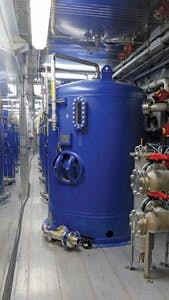Each spring, the quality of the process water at a pulp mill in eastern Canada would suffer when the seasonal snowmelt generated large volumes of runoff into a nearby lake and its tributaries, pushing additional debris, dirt and iron into the facility’s aging clarification system.
In turn, this cost the company hundreds of thousands of dollars per day in lost revenue because the pulp it was producing did not meet the strict prime brightness standards for the manufacture of rayon for the textile industry, the highest value end use for the highly purified form of cellulose made from wood. The brightness reduction of the pulp product was directly correlated with the wash and process water containing higher-than-normal levels of iron and other naturally occurring colorants.
To meet its process water quality specifications, mill officials would have to slow down the flow rate of their clarification system because of inadequate filtration capacity from both their gravity and sand filter systems to deal with the added iron and particulate loading. However, this reduction in flow would cause the facility not to have enough filtered water for its other processes. As a result, to meet the needed flow rates, mill officials were forced to open a filter bypass, causing severe degradation in the brightness of the finished product.
Mill officials initially were hesitant to explore outsourced solutions, figuring that any solution to their water quality problems would be extremely costly because the facility requires as much as 16,000 gal per minute (gpm) of purified water, up to half of which is highly filtered for pulp production. The balance of the flow is used for cooling, which also benefits from higher-quality water via more efficient heat exchange at lower contaminant levels.
Moreover, the company was unable to shut down its water purification system for repairs or inspection for a variety of reasons. First, a shutdown in early spring could risk freezing the water system piping inside the plant. Second, pulp manufacturing is a commodity business subject to the vagaries of spot marketing pricing. Even a brief outage can have a significant financial impact in this capital-intensive, small-margin industry.
Cost-Effective Purification System
The core of the challenge was to design and implement a cost-effective water purification system that would enable the mill to meet its quality and flow requirements, helping the company to capture the full value of the pulp it produces for the rayon manufacturing industry—without interrupting production.
After receiving the call at its logistics center in Ohio, MPW’s Industrial Water division developed a proposal for the mill’s consideration within hours and was ready to deploy the solution within two days. The plan included the use of three trailer-mounted media filtration units capable of producing up to 2,500 gpm with a water quality of less than 1 ntu.
The plan was to treat only a portion of the water generated by the mill’s clarifier, effectively closing the bypass valve. In addition, MPW recommended the mill operate its own sand and gravity filtration system at a slower rate by making use of its full capacity, improving the quality of water it generates. Nonetheless, the water from the sand and gravity system during the spring runoff can have turbidity between 2 and 4 ntu. The theory was that combining the highly polished water from media filtration with water from the reduced-flow sand and gravity systems would meet requirements to stay on prime-grade brightness pulp.
The MPW trailers featured automated backwashing, reducing the equipment and labor costs. The system also was capable of injecting chemicals, if needed, to meet the mill’s quality requirements even with extreme inlet water quality upsets up to 50 ntu. All controls for operations, chemical injection, online turbidity and other devices were capable of being operated remotely via the Internet. The system required one MPW employee per day on site during daylight hours to monitor operations, verify customer flow rate demand, etc. This same person also was able to operate the system remotely from his or her laptop computer or tablet. The logistics center also could operate the system.
Results
The solution exceeded expectations for water quality and flow rates. The media filtration units met the challenge without the use of chemical injections for the approximately two months MPW was on site. Treating a portion of the mill’s water to a high degree and then blending it back into water from the existing gravity and sand filtration system resulted in product brightness above grade for the entire deployment, and gains in the customer’s bottom line.
MPW now is called upon regularly to augment the mill’s water purification processes, for example, in the fall, when the feed water conditions are similar to springtime. Furthermore, MPW has refined its processes and coordination with the mill in that the company now dispatches two trailers, and no chemical injections have been required.
Download: Here


